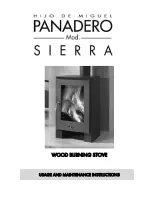
Tilga Insert
2
Tilga Insert
15
Troubleshooting
(Continued)
Read and follow these instructions carefully before installing and
using this appliance.
WARNING
!
WARNING
!
Safety Warnings
•
A flue fire with resulting damage may occur if the appliance is not installed,
operated and maintained as per this booklet.
•
Never place combustible materials such as wood, paper or furniture near the
appliance.
•
This appliance is designed to burn dry wood. Do not burn rubbish, driftwood,
flammable liquids or any substance containing salts or corrosives.
•
This appliance must not be installed and operated in an area where kerosene,
petrol, paint thinner or other flammable liquid is used or stored.
•
The flue system must be inspected and cleaned annually or sooner if required.
Failure to do so could result in an excessive buildup of creosote which may
result in a flue fire, which may damage the flue or cause damage to your home.
•
The surface of the appliance becomes hot during operation. Do not touch the
surface of this appliance. Keep children away from this appliance during
operation. Do not allow anyone to operate this appliance who is not familiar
with this instruction booklet.
WARNING
!
Paint Curing and Care
Your heater is coated with the best available heat resistant paint. Even though
the paint has been baked after application, it may require further temperature
curing. It may, if you overfire the heater on its first fire, discolour. For your first
two or three firings, never exceed medium air setting and always have the fan
on when above low burn. Do not wipe the heater while the paint is curing. After
the paint has cured the only maintenance required to maintain the heater’s finish
is to wipe it with a soft cloth. Do not use any commercial cleaners or solvents on
the paint finish.
We are proud of the presentation of our products. If at any time you need to
freshen up the paint, your local dealer has touchup paint available for purchase.
You may even change the colour of your heater if you wish.
If you have any enquiries, please contact the dealer from whom you purchased your heater:
PLEASE COMPLETE:
Dealer Name
Dealer Address
Phone:
Please attach your original purchase dockets to this booklet for future reference.
To aid heater installation, remove door, baffle system and cast iron liners to reduce
overall heater weight.
Firewood
Getting the most out of your firewood
Firewood is a sustainable source of energy and when used correctly can provide a cost effective form of heating in your
home. Too often poor heating results and operational issues are attributed to using unseasoned wood which leads to
excess smoking, causing creosote buildup and dirty glass. Wood should be stored in a dry place where good ventalition is
available. Freshly cut wood should be stored for between 12-24 months before burning.
Use only hardwood with your Jindara Tilga.
Thermal efficiency
A wood’s efficiency does not depend only on its type, but also on its moisture content as well as the temperature of the
combustion chamber. To achieve a greater efficiency and longer burn cycle out of your Jindara Tilga, without the emissions
of hazardous particulates, your wood must be well seasoned.
Ideally, wood should not be burnt when its moisture content is above 20%. A moisture meter to measure moisture content
is a handy addition.
0% moisture
100% thermal efficiency
10% moisture
88% thermal efficiency
30% moisture
63% thermal efficiency
50% moisture
39% thermal efficiency
An example of available thermal efficiency for a piece of wood as a fuel source at varying moisture levels.
The combustion process of burning wood
When wood is heated up to approximately 100 degrees celsius, moisture begins to evaporate from the fuel. There is no
heating value from the wood at this point. As moisture releases from the wood, it reduces the efficiency of the combustion
process robbing heat energy from the wood. This demonstrates the importance of dry and well seasoned wood.
As firebox temperatures reach 250-300 degrees celsius, wood solids begin to break down and release volatile gases which
ignite and produce heat.
From 300+ degrees celsius, the main energy available from wood is released when fuel vapors containing up to 60% of
the wood’s potential heat is released.
Understanding combustion principles and learning how to manipulate various conditions surrounding the operation of
your Jindara Tilga enables you to achieve maximum comfort and efficiency from your Australian made wood heater.
Figure 14
This heater is painted in stovebrite Metallic Black - code 6309.


























